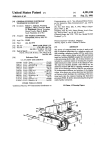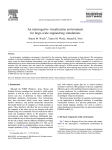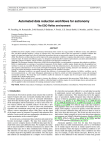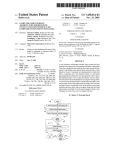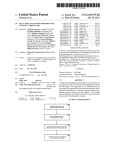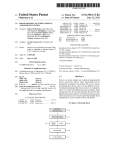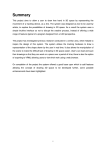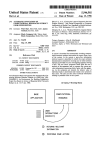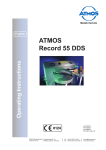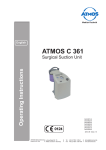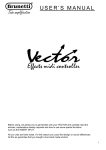Download Clickless user interaction with text-to
Transcript
US007788100B2 (12) United States Patent (10) Patent N0.: (45) Date of Patent: Slotznick et a]. (54) (56) CLICKLESS USER INTERACTION WITH TEXT-TO-SPEECH ENABLED WEB PAGE FOR USERS WHO HAVE READING DIFFICULTY *Aug. 31, 2010 References Cited U.S. PATENT DOCUMENTS (75) Inventors: Benjamin Slotznick, 507 Third St., Mt. Gretna, PA (US) 17064; Stephen C. Sheetz, Lebanon, PA (US) 5,287,102 A 2/1994 McKiel, Jr. 5,528,739 5,715,370 5,748,186 5,899,975 6/1996 2/1998 5/1998 5/1999 A A A A 6,018,710 A 6,023,714 A Lucas et al. Luther et al. Raman Nielsen 1/2000 Wynblatt et al. 2/2000 Hill et al. (73) Assignee: Benjamin Slotznick, Mt. Gretna, PA (Us) Notice: US 7,788,100 B2 (Continued) OTHER PUBLICATIONS Subject to any disclaimer, the term of this patent is extended or adjusted under 35 Speaks for Itself Talking Web Sites, printout from Web site: http:// U.S.C. 154(b) by 476 days. WWW.speaksforitself.com/speaksforitself/talkingsites. This patent is subject to a terminal dis claimer. unknown, 4 pages. cfm?CFID:1327376&CFTOKEN:48412529 DirectXtras, Inc., printout date: Feb. 15, 2002, original Web page posting date: (Continued) (21) Appl. No.: 11/717,560 (22) Filed: Primary ExamineriRichemond Dorvil Assistant ExamineriDouglas C Godbold (74)Att0rney, Agent, orFirmiPanitch SchWarZe Belisario & Mar. 13, 2007 (65) Nadel LLP Prior Publication Data US 2008/0114599 A1 May 15, 2008 (57) Related US. Application Data (63) (60) ABSTRACT Web pages and other text documents displayed on a computer are reformatted to alloW a user Who has dif?culty reading to Continuation of application No. 10/084,582, ?led on Feb. 25, 2002, noW Pat. No. 7,194,411. navigate betWeen and among such documents and to have such documents, or portions of them, read aloud by the com puter using a text-to-speech engine in their original or trans Provisional application No. 60/271,677, ?led on Feb. lated form While preserving the original layout of the docu 26, 2001. ment. A “point-and-read” paradigm alloWs a user to cause the (51) G10L 21/00 (52) (58) text to be read solely by moving a pointing device over graphi Int. Cl. (2006.01) cal icons or text Without requiring the user to click on any US. Cl. ................... .. 704/270.1; 704/260; 704/272 Field of Classi?cation Search ............... .. 704/260, thing in the document. Hyperlink navigation and other pro gram functions are accomplished in a similar manner. 704/270, 270.1, 272 See application ?le for complete search history. 8 Claims, 13 Drawing Sheets FROM 12] 1mm WEBPAGE wrrn TEXT-Tosrmcn 1" USER PLACES CURSOR Ill! TEXT-TO-SPEECH MODULE coma rams rm MOVE cunson BACK oven MO TEXHOSPEECH MODULE m TBXTCONVBRTED m'ro SOUNDFILE "1 SOUNDS PLAYED ovm SPEAKERS m TO 123 US 7,788,100 B2 Page 2 US. PATENT DOCUMENTS 6,085,161 A 6,115,686 A 7/2000 MacKenty et al. 9/2000 Chung et al. 6,324,511 B1* 11/2001 6,442,523 B1* 8/2002 6,580,416 6,665,642 6,708,152 6,728,763 Kiraly et a1. .............. .. 704/260 Siegel ...... .. . B1* 6/2003 Gardner B2 12/2003 Kanevsky et al. B2 3/2004 Kivimaki B1 4/2004 Chen 7,219,164 B2 * 2002/0065658 A1 5/2007 Shelley ..................... .. 709/246 5/2002 Kanevsky et al. OTHER PUBLICATIONS Bonner, P., “And Web Sites for All,” Internet Professional-Solutions for Web Designers and Builders, PC Magazine, May 7, 2002, IP01iIP03 (3 pages). International Search Report for PCT/US02/06041, mail date: May Jaws Screenreader for the Blind and Visually Impaired, printout from web site: http://www.worklink.net/jaws.htrn, printout date: Feb. 20, 2001, original web page posting date: unknown, 1 page. Parsing with Perl Modules by Teodor Zlatonov, printout from IBM web site: http://www-106.ibm.com/developerworks/linux/library/ perl-parsing/ printout date: Feb. 15, 2002, article date: Apr. 2000, 6 pages. DevGuru HTML core attribute: onmouseover, printout from web site: http://www.devguru.com/Technologies/html/quickref/ htmliprintout date: Feb. 11, 2002, original web page positing date: unknown, 2 pages. Clickless Ad, printouts from cnet.com web site: http://builder.cnet. com/webbuilding/0-7600-8-5828510-1.html?tag:st.bl.7600-8 58281 13-1 .txt.7600-8-... printout date: Feb. 15, 2002, date submitted to web site: Jun. 24, 1998, original web page posting date: unknown, 3 pages. 31,2002, 1 page. HTML Tutorials: Span Tag, printout from web site: http://hypergurl. com/span.html printout date: Feb. 8, 2002, original web page posting International Preliminary Examination Report (IPER) for PCT/ date: unknown, 2 pages. US02/06041, mailed Dec. 13, 2002, 4 pages. Clickless Link by Joey Mornin, printouts from web site: http://www. scriptlib.com... printout date: Feb. 12, 2002 and Feb. 15, 2002, origi Corrected International Preliminary Examination Report (IPER) for PCT/US02/06041, mailed Apr. 3, 2003, 10 pages. BrowseAloud User Manual dated Aug. 23, 2002, printout from Spectronics web site: http://www.spectronicsinoZ.com/library. asp?article:12331&displa}Pprint, printout date: Jul. 25, 2003, 4 pages. BrowseAloud Screen Reader, Press Release dated Nov. 26, 2002, printout from Access Ingenuity web site: http://www.accessingenu ity.com/Product%20Pages/browsealoudpressrelease.htm, printout date: Jul. 25, 2003, 2 pages. Microsoft Agent 2.0 Setup (includes step to Install the Lernout & Hauspie TruVoice Text-to-Speech Engine), printout from web site: http://www.msagentring.org/setuphtm printout date: Feb. 15, 2002, nal web page posting date: unknown, 5 pages. Event and Event Handlers: onMouseOver, printout from Netscape web site: http://developer.netscape.com/docs/manuals/communica tor/itsref/evnt17.htm printout date: Feb. 15, 2002, original web page posting date: unknown, 2 pages. WordSmith v2.0 article describing Jan. 15, 2001 product launch, printout from Sight and Sound Technology website: http://www. sightandsound.co.uk/pages/WordSmithiintroiprint.htrn, printout date: Jul. 25, 2003, 2 pages. textHELP! ® Support Centre, Discussion Area with message posting about BrowseAloud from May 16, 2001 through Jul. 18, 2002, print outs from textHELP website (and links therein): http://www. original web page posting date: unknown, 2 pages. Help Read Beta .92, printout from web site: http://www.davecentral. com/projects/helpread/printout date: Feb. 26, 2001, original web page posting date: unknown, 2 pages. Cast eReader, printout from web site: http://www.cast.org/udl/index. cfm?i:211 printout date: Feb. 26, 2001, original web page posting printout date: Jul. 25, 2003, 8 pages. Search Report for GB0509518.7 Patent Application, mail date of Search Report: Jul. 6, 2005, 1 page. date: unknown, 5 pages. * cited by examiner texthelp.com/discussion/forum.asp?ForumID:5§ion:support, US. Patent Aug. 31, 2010 Sheet 4 0f 13 US 7,788,100 B2 US. Patent Aug. 31, 2010 Sheet 5 0f 13 ......... US 7,788,100 B2 US. Patent Aug. 31, 2010 Sheet 6 0f 13 US 7,788,100 B2 . w@gww US. Patent Aug. 31, 2010 Sheet 7 0f 13 US 7,788,100 B2 U S. Patent Aug. 31, 2010 Sheet 8 0f 13 US 7,788,100 B2 MyMW?“ US. Patent Aug. 31, 2010 Sheet 9 0f 13 US 7,788,100 B2 US. Patent Aug. 31, 2010 Sheet 10 0f 13 US 7,788,100 B2 hu . wryA.» we Aw US. Patent Aug. 31, 2010 Sheet 11 0113 US 7,788,100 B2 US. Patent Aug. 31, 2010 Sheet 12 0113 US 7,788,100 B2 US. Patent Aug. 31, 2010 Sheet 13 0f 13 3%$“3%a3w“anmn.aM“3g" US 7,788,100 B2 US 7,788,100 B2 1 2 CLICKLESS USER INTERACTION WITH TEXT-TO-SPEEC H ENABLED WEB PAGE FOR USERS WHO HAVE READING DIFFICULTY an image, and the screen reader Would speak the description of image. Similarly, a screen reader that encounters a hyper CROSS-REFERENCE TO RELATED APPLICATIONS the page to Which the hyperlink links. (This is information link Would indicate that an image or text is acting as a link in addition to reading the text or describing the image using the alt tag text. The screen reader might even read the address of that a sighted person Would see on the broWser’s status line When the cursor is placed over the link.) Some screen readers have also been developed as reading This application is a continuation of US. application Ser. No. 10/084,582 ?led Feb. 25, 2002, now US. Pat. No. 7,194, aids for the sighted, particularly sighted persons Who have 411, Which is incorporated herein by reference. dif?culty learning to read. TWo examples are the CAST This application claims the bene?t of US. Provisional Application No. 60/271,677 ?led Feb. 26, 2001 entitled “A eReader, available from CAST, Peabody, Mass., and the METHOD OF DISPLAYING WEB PAGES TO ENABLE USER ACCESS TO TEXT INFORMATION THAT THE USER HAS DIFFICULTY READING.” Literacy Project (HELP), Honolulu, Hi. HELPReadTM plug-in, available from the HaWaii Education The CAST eReader Will read documents or Web pages. The user places the cursor focus in front of the text on a document COMPACT DISC APPENDIX This patent application includes anAppendix on one com 20 pact disc having a ?le named appendix.txt, created on Mar. 8, 2007, and having a siZe of 35,167 bytes. The compact disc is incorporated by reference into the present patent application. COPYRIGHT NOTICE AND AUTHORIZATION that he or she Wants the eReader to read. This is performed by placing the cursor at that location and then clicking the left mouse button. The eReader Will then read the next letter, Word or sentence (depending upon user settings, hoWever, for Web pages, only Whole sentences are read). As the eReader vocal iZes the text, it Will “highlight” the letter, Word or sentence being read (depending upon user settings, hoWever, for Web pages, only Words are highlighted). (When a Word is “high 25 lighted” its background shoWs a different color as if it had been highlighted by a magic marker.) The eReader can read Portions of the documentation in this patent document one piece of text at a time, or automatically continue through contain material that is subject to copyright protection. The an entire document. The user can also highlight a portion of copyright oWner has no objection to the facsimile reproduc tion by anyone of the patent document or the patent disclosure text (by pointing and clicking With a cursor), and then click on 30 a button for the eReader to read that text. The eReader can also as it appears in the Patent and Trademark O?ice ?le or be automatically set to begin reading from the top any Web records, but otherwise reserves all copyright rights Whatso page it encounters. The HELPRead plug-in has a different interface but per forms similar functions: user identi?cation of text to be read ever. BACKGROUND OF THE INVENTION 35 Current computer programs called “screen readers” use text-to-speech softWare to “read” the text displayed on a computer screen. (One example is the JAWS screen reader program, available from A.D.A. WorkLink, Berkeley, Calif. Another is Microsoft’s Narrator accessibility softWare built into WindoWs 2000.) Some have been adapted for or incor porated into Web broWsers, in order to “read” Web pages or e-mail. Because this class of softWare has generally been designed for the blind or visually impaired, the reader must from top to bottom of a document, or they require a double 40 specify the address of a Web page, and then parse that entire page, translating all text, but not translating the formatting 45 50 Some “portal” Websites like Octopus (Octobus.com, LLC, page, by identifying other Web pages and specifying material 55 in that other Web page. When the user next visits Octopus, Octopus in the background creates the personaliZed Web page for the user by parsing those other Websites for the requested information and reconstituting it on an Octopus page, before delivering it to the user. 60 Text-to-speech softWare has also been adapted as plug-ins for Internet broWsers. These may be stand-alone speech syn thesis programs, or may be coupled With an animation pro gram, so that a “cartoon” Will appear to speak the Words. TWo such programs are the Haptek Virtual Friend animation pro page may include not only the source of the image, but a textual description of What the image is or shoWs (the text folloWing the “alt” tag). A screen reader Would then indicate through aural tones, or spoken Words that the page contained WWW.systransoft.com Website of Systran S.A., France/ Systran SoftWare, San Diego, Calif.) HoWever, unlike the previous example, the parsing is done at the translation Web Palo Alto, Calif.) alloW the user to create a personaliZed Web ting codes needed for page display (e.g., margins, italics, etc.). Some of the formatting codes cause the parsing program to insert additional code for the text-to-speech reader. For example, formatting code to place a Word in boldface might be changed to add code that makes the text-to-speech pro gram speak that Word louder. In other instances, the parsing program inserts Words to describe What the formatting code sought to accomplish. For example, an image tag in a Web code, and causing the translated page to appear in the user’s Web broWser, With the same or similar formatting, images, typeface, etc. as the original Web page. (An example is the site’s server, rather the user’s computer. “link” can be activated, as Well as What the button does and Where the link navigates. To do this, the screen reader “parses” the digital code that makes up the text and formatting instructions for the page. The actual text is put in the proper form for the text-to-speech softWare Without the extra format step point-and-click. There are other current uses for such parsing routines. Some Websites for translation services alloW the user to also provide aural signals of important non-text information, such as symbols, non-standard punctuation, and a description of pictures embedded in the text. When the screen reader is intended to read Web pages, the screen reader also has to describe animations or videos, and signal When a “button” or by point-and-click or by highlighting, and highlighting text While it is being read. The HELPRead plug-in Will also read any text placed in the clipboard. Both of these readers are either fully automated reading 65 gram (available from Haptek, Inc., Santa CruZ, Calif.) Which in February 2001 Was coupled With DECtalk text-to-speech program (available from Fonix Corporation, Draper, Utah) US 7,788,100 B2 3 4 and the Microsoft Agent animation program Which is fre requested language. There are a variety of text-to-speech quently coupled With the Lernout & Hauspie TruVoice text to-speech program. (Apple computer also has a text-to speech program called PlainTalk.) These various plug-ins can be accessed from Web pages that have embedded the appro softWare packages that a user can install and submit text to, Whereby the text is converted to the sound of a synthesiZed voice speaking the Words. These applications generally priate code, causing certain predesignated portions of the Web require that the user is competent With reading and manipu lating high school level text in at least one language. Text-to page to be spoken. The Web page designer/creator decides Which portions of the Web page Will “talk”. socio-economic levels, frequently costing end users over An authoring application that helps Web designers use Microsoft Agent is Buddy Builder by Shelldrake Technolo matiZe the users Who may otherWise effectively hide their gies, Concord, NH. A Web page that uses this softWare reading di?iculties. includes a link, that When activated, launches a neW broWser WindoW. The neW broWser WindoW displays a modi?ed ver intervieWs, commentary, or audio descriptions of graphics. sion of the Web page. This Web page Will “speak” When the HoWever, production time and storage capacity requirements broWser registers various events (e.g., onLoad, onMouseover, limit their use. speech broWsers are also an expense for those in the loWer $100. Use of such specialiZed broWsers is also likely to stig Some electronic texts embed audio clips, such as songs, onClick) With respect to speci?c page elements. This program only speaks certain page elements previously designated by BRIEF SUMMARY OF THE INVENTION the Web page author. Prior to Feb. 26, 2001, the Simtalk Website (WWW. simtalk. com) alloWed users to specify certain Websites (such as neWs on Yahoo, or books in the Gutenberg Project). The Simtalk The present invention provides a method of reformatting 20 that alloWs a user Who has dif?culty reading to (a) navigate betWeen and among such documents and, (b) have such docu ments (or portions of them) read to him or her (in their original or translated form) While preserving to a large extent softWare parsed the Website, and placed it in a form compat ible With text-to speech softWare. An animated head appeared on the computer monitor, along With a neW WindoW With control buttons. When the user clicked on the “read” button, the text-to-speech softWare read portions of the Website pre selected by Simtalk, While the animated head moved its mouth in synchronization With the Words (called “lip-sync ing” the Words). This process Worked by executing an inde pendent softWare program (i.e., the Simtalk softWare) Which parsed sentences and text strings from Web pages and loaded Web pages and other text documents displayed on a computer 25 the original layout of the document. The invention imple ments a “point-and-read” paradigm, Whereby the user indi cates the text to be read by moving a mouse (or pointer device) over the icon or text. (In other instances, the indication occurs by clicking on an icon or text.) Hyperlink navigation and 30 other program functions are accomplished in a similar man ner. them into an array of a table. When the user clicked on the WindoW of the Simtalk softWare reader, the sentences in the table Were sequentially read one-by-one out of the array, loaded into a text-to-speech function, and spoken. In US. application Ser. No. 09/974,132 ?led Oct. 9, 2001, BRIEF DESCRIPTION OF THE DRAWINGS 35 entitled “METHOD OF PROCESSING INFORMATION EMBEDDED IN A DISPLAYED OBJECT,” incorporated herein by reference, text from one Web page could be copied from one WindoW (using drag-and-drop or copy-and-paste operations) to another WindoW, Where it Would be put in the proper form to be read by text-to-speech softWare. loWing draWings. For the purpose of illustrating the invention, 40 Many people have dif?culty reading any speci?ed text ently preferred, and an example of hoW the invention is used talities shoWn. In the draWings: 45 FIG. 1 shoWs a How chart of a preferred embodiment of the present invention; language. (In the United States, this literacy problem is FIG. 2 shoWs a How chart ofa particular step in FIG. 1, but attacked by the special educational programs and efforts With greater detail of the sub-steps; referred to as “ESL” programs or “English as a Second Lan guage.”) People have dif?culty reading a document that is Written With technical terms that they are not familiar With. there is shoWn in the draWings an embodiment that is pres in a real -World project. It should be understood that the inven tion is not limited to the precise arrangements and instrumen document, even if they are not blind. People have dif?culty reading a document that is not Written in their native or ethnic The above summary, as Well as the folloWing detailed description of a preferred embodiment of the invention, Will be better understood When read in conjunction With the fol FIG. 3 shoWs a How chart of an alternate embodiment of the 50 People have dif?culty reading a document that is Written With present invention; FIG. 4 shoWs a screen capture of the present invention more dif?cult Words or sentence constructions than they are illustrated in FIG. 3; competent to decipher. (For example, in the United States, FIG. 5 shoWs a screen capture of the present invention almost a quarter of the adult population reads at or beloW the displaying a particular Web page With modi?ed formatting, after having navigated to the particular Web page from the fourth grade level and has dif?culty reading and understand 55 ing the directions on the back of a medicine bottle.) Other FIG. 3 screen; FIG. 6 shoWs a screen capture of the present invention after the user has placed the cursor over a sentence in the Web page people have dif?culty reading any text because of dyslexia, mental retardation, or various developmental or cognitive disabilities. Other people have dif?culty reading because of cultural or educational disabilities. Some of those Who have 60 dif?culty reading may be sighted but have motor control disabilities Which make drag-and-drop, point-and-click or shoWn in FIG. 5; and FIGS. 7-13 shoW screen captures of another preferred embodiment of the present invention. copy-and-paste operations dif?cult. Some electronic texts (such as some Web sites) provide alternate texts in a feW different languages. Some Web sites provide automated machine translation of any text or Web page that is submitted to them, by displaying text in the DETAILED DESCRIPTION OF THE INVENTION 65 Certain terminology is used herein for convenience only and is not to be taken as a limitation on the present invention. US 7,788,100 B2 5 6 In the drawings, the same reference letters are employed for For example, if a link in WEBPAGE 1 contained the text “Buy designating the same elements throughout the several ?gures. before lightning strikes” and a picture of clear skies, along With the code 1. Overview of Present Invention onMouseOveF“ShoWLightning( )” A preferred embodiment of the present invention takes one Web page Which Would ordinarily be displayed in a broWser WindoW in a certain manner (“WEBPAGE l”) and displays Which makes lightning ?ash in the sky picture, WEBPAGE 2 Would contain the code onMouseOveF“CursorOver(‘Buy before lightning that page in a neW but similar manner (“WEBPAGE 2”). The neW format contains additional hidden code Which enables the Web page to be easily read aloud to the user by text-to strikes’); ShoWLightning( );” The invention avoids con?icts betWeen function calls to the computer sound card in several Ways. No con?ict arises if both function calls access Microsoft Agent, because the tWo speech softWare. The present invention reads the contents of WEBPAGE l texts to be “spoken” Will automatically be placed in separate (or more particularly, parses its HTML code) and then “on the-?y” in real time creates the code to display WEBPAGE 2, queues. If both functions call the sound card via different softWare applications and the sound card has multi-channel in the folloWing manner: (l)All standard text (i.e., sentence or phrase) that is not Within link tags is placed Within link tags to Which are added an processing (such as ESS Maestro2E), both softWare applica tions Will be heard simultaneously. Alternatively, the tWo applications can be queued (one after another) via the coding “onMouseover” event. The onMouseover event executes a JavaScript function Which causes the text-to-speech reader 20 to read aloud the contents Within the link tags, When the a plug-in is created that monitors data streams sent to the sound card. These streams are suppressed at user option. For user places the pointing device (mouse, Wand, etc.) over the link. Font tags are also added to the sentence (if necessary) so that the text is displayed in the same color as it Would be in WEBPAGE lirather than the hyperlink colors (default, that the present invention adds to WEBPAGE 2. Alternatively, 25 example, if the sound card is playing streaming audio from an Internet “radio” station, and this streaming con?icts With the text-to-speech synthesis, the streaming audio channel is auto active or visited hyperlink) set for WEBPAGE l. Conse quently, the standard text Will appear in the same color and matically muted (or softened). font on WEBPAGE 2 as on WEBPAGE 1, With the excep from the link tag for text (part 1 above). (The href value is the tion that in WEBPAGE 2, the text Will be underlined. (2) All hyperlinks and buttons Which could support an onMouseover event, (but do not in WEBPAGE 1 contain an onMouseover event) are given an onMouseover event. The onMouseover event executes a JavaScript function Which causes the text-to-speech reader to read aloud the text Within the link tags or the value of the button tag, When the In an alternative embodiment, the href value is omitted 30 the original font color of WEBPAGE l and is not underlined. 35 user places the pointing device (mouse, Wand, etc.) over the link. Consequently, this type of hyperlink appears the same on WEBPAGE 2 as on WEBPAGE l. (3) All buttons and hyperlinks that do contain an onMou seover event are given a substitute onMouseover event. The 40 substitute onMouseover event executes a JavaScript func tion Which ?rst places text that is Within the link (or the value of the button tag) into the queue to be read by the text-to-speech reader, and then automatically executes the original onMouseover event coded into WEBPAGE 1. Consequently, this type of hyperlink appears the same on 45 WEBPAGE 2 as on WEBPAGE l. (4) All hyperlinks and buttons are preceded by an icon placed Within link tags. These link tags contain an onMouseover event. This onMouseover event Will execute a JavaScript 50 function that triggers the folloWing hyperlink or button. In other Words, if a userplaces a pointer (e.g., mouse or Wand) mouse is moved outside of this text, the text returns to its original color. In an alternate embodiment, the text does not return to its original color but becomes some other color so that the user visually can distinguish Which text has been read and Which has not. This is similar to the change in color While a hyperlink is being made active, and after it has been acti vated. In some embodiments these changes in color and appearance are effected by Cascading Style Sheets. An alternative embodiment eliminates the navigation icon seover event is Written differently, so that after the text-to 55 This alloWs tWo classes of disabled users to access the Web 60 objects. In many implementations of JavaScript, for part (3) above, WEBPAGE l) and the neW onMouseover function call used in part (2) can be placed in the same onMouseover handler. lined. This neW tag is recogniZed by the neW built in routines. WEBPAGE 2 appears very much like WEBPAGE 1. In an alternate embodiment, When the onMouseover event is triggered, the text that is being read appears in a different color, or appears as if highlighted With a Magic Marker (i.e., the color of the background behind that text changes) so that the user knoWs visually Which text is being read. When the speech softWare is ?nished reading the link, a timer Will start. page, those Who have di?iculty reading, and those With dex terity impairments that prevent them from “clicking” on both the original onMouseover function call (as in Thus, WEBPAGE 2 appears even more like WEBPAGE 1. In an alternative embodiment, a neW HTML tag is created that functions like a link tag, except that the text is not under (part 4 above) placed before each link. Instead, the onMou over the icon, the broWser acts as if the user had clicked the subsequent link or button. As is evident to those skilled in the art, WEBPAGE 2 Will appear almost identical to WEBPAGE 1 except all standard text Will be underlined, and there Will be small icons in front of every link and button. The user can have any sentence, link or button read to him by moving the pointing device over it. address or URL of the Web page to Which the broWser navi gates When the user clicks on a link.) In broWsers, such as Microsoft’ s Internet Explorer, the text in WEBPAGE 2 retains 65 If the cursor is still on the link after a set amount of time (such as 2 seconds), the broWser Will navigate to the href URL of the link (i.e., the Web page to Which the link Would navigate When clicked in WEBPAGE 1). If the cursor has been moved, no navigation occurs. WEBPAGE 2 appears identical to WEBPAGE 1. An alternative embodiment substitutes “onClick” events for onMouseover events. This embodiment is geared to those Whose dexterity is su?icient to click on objects. In this embodiment, the icons described in (4) above are eliminated. An alternative embodiment that is geared to those Whose dexterity is su?icient to click on objects does not place all text Within link tags, but keeps the icons described in (4) in front US 7,788,100 B2 7 8 of each sentence, link and button. The icons do not have onMouseover events, however, but rather onClick events In an alternative embodiment, the user accesses the present invention from a Web page With framesets that make the Web Which execute a JavaScript function that causes the text-to page look like a broWser (“WEBPAGE BROWSER”). One of speech reader to read the following sentence, link or button. In the frames contains buttons or images that look like the con this embodiment, clicking on the link or button on trol objects usually found on broWsers, and these control WEBPAGE 2 acts the same as clicking on the link or button on WEBPAGE 1. objects have the same functions usually found on broWsers (e.g., navigation, search, history, print, home, etc.). These functions are triggered by onMouseover events associated With each image or button. The second frame Will display Web An alternative embodiment does not have these icons pre cede each sentence, but only each paragraph. The onClick pages in the form of WEBPAGE 2. When a user submits a event associated With the icon executes a JavaScript function Which causes the text-to-speech reader to read the Whole paragraph. An alternate formulation alloWs the user to pause the speech after each sentence or to repeat sentences. An alternative embodiment has the onMouseover event, URL (Web page address) to the WEBPAGE BROWSER, the user is actually submitting the URL to a CGI script at a server. The CGI script navigates to the URL, doWnloads a page such as WEBPAGE l, parses it on-the-?y, converts it to WEBPAGE 2, and transmits WEBPAGE 2 to the user’s com Which is associated With each hyperlink from WEBPAGE 1, read the URL Where the link Would navigate. A different puter over the Internet. The CGI script also changes the URLs of links that it parses in WEBPAGE l. The links call the CGI alternative embodiment reads a phrase such as “When you click on this link it Will navigate to a Web page at” before reading the URL. In some embodiments, this onMouseover event is replaced by an onClick event. In an alternative embodiment, the text-to-speech reader script With a variable consisting of the originally hyperlink URL. For example, in one embodiment, if the hyperlink in 20 er.pl, then the href of the hyperlink in WEBPAGE 2 reads speaks nonempty “alt” tags on images. (“Alt” tags provide a href:http//WWW.simtalk.com/cgi-bin/ text description of the image, but are not necessary code to display the image.) If the image is Within a hyperlink on WEBPAGE 1 had an hrefIhttp://WWW.nytimes.com and the CGI script Was at http://WWW.simtalk.com/cgi-bin/Webread Webreader.pl?originalUrlqvWW.nytimes.com. 25 When the user activates this link, it invokes the CGI script and directs WEBPAGE l, the onMouseover event Will add additional code that Will speak a phrase such as “This link contains an the CGI script to navigate to the hyperlink URL for parsing image of a” folloWed by the contents of the alt tag. Stand alone images With nonempty alt tags Will be given onMou seover events With JavaScript functions that speak a phrase Width than When the present invention is integrated into the and modifying. This embodiment uses more Internet band 30 such as “This is an image of’ folloWed by the contents of the alt tag. An alternate implementation adds the neW events to the use the computers at any facility. This is particularly impor arrays of obj ects in each document container supported by the broWser. Many broWsers support an array of images and an array of frames found in any particular document or Web tant for less af?uent individuals Who do not have their oWn 35 40 the changes to properties of individual elements of the array or all elements of a given class (P, H1, etc.). For example, by all text contained in <Hl> tags turns blue. In this implemen tation (Which requires that the tag array alloW access to the hyperlink text as Well as the onMouseover event), rather than parsing each document completely and adding HTML text to An alternative embodiment takes the code from the CGI script and places it in a ?le on the user’s computer (perhaps in a different computer programming language). This embodi ment then sets the home page of the broWser to be that ?le. The modi?ed code for links then calls that ?le on the user’s oWn computer rather than a CGI server. Writing document.tags.Hl .coloF“blue”; computers, and Who access the Internet using public facilities such as libraries. page. These are easily accessed by JavaScript (e.g., docu ment.frames[ ] or document.images[ ]). In addition, Netscape 4.0+, supports tag arrays (but Microsoft Internet Explorer does not). In this implementation, JavaScript code then makes broWser, and greater server resources. HoWever, this embodi ment can be accessed from any computer hooked to the Inter net. In this manner, people With disabilities do not have to bring their oWn computers and softWare With them, but can Alternative embodiments do not require the user to place a 45 50 cursor or pointer on an icon or text, but “tab” through the document from sentence to sentence. Then, a keyboard com mand Will activate the text-to-speech engine to read the text Where the cursor is placed. Alternatively, at the user’s option, the present invention automatically tabs to the next sentence and reads it. In this embodiment, the present invention reads the document, all changes are made using JavaScript. The aloud the document until a pause or stop command is initi internal text in each <A> tag is read, and then placed in neW ated. Again at the user’s option, the present invention begins reading the document (WEBPAGE 2) once it has been dis onMouseover handlers. This implementation requires less parsing, so is less vulnerable to error, and reduces the docu ment siZe of WEBPAGE 2. 55 played on the screen, and continues reading the document until stopped or until the document has been completely read. In a preferred embodiment of the present invention, the Alternative embodiments add speech recognition softWare, parsing routines are built into a broWser, either directly, or as a plug-in, as an applet, as an object, as an add-in, etc. Only WEBPAGE l is transmitted over the Internet. In this embodi ment, the parsing occurs at the user’s client computer or so that users With severe dexterity limitations can navigate Within a Web page and betWeen Web pages. In this embodi 60 Internet applianceithat is, the broWser/plug-in combination trigger the text-to-speech softWare, and other voice com gets WEBPAGE 1 from the Internet, parses it, turns it into WEBPAGE 2 and then displays WEBPAGE 2. If the user has mands activate a link for purposes of navigating to a neW Web page. When the user has set the present invention to automati dexterity problems, the control objects for the broWser (but tons, icons, etc.) are triggered by onMouseover events rather than the onClick or onDoubleClick events usually associated With computer applications that use a graphical interface. ment, voice commands (such as “TAB RIGHT”) are used to tab or otherWise navigate to the appropriate text or link, other voice commands (such as “CLICK” or “SPEAK”) are used to 65 cally advance to the next text, voice commands (such as “STOP”, “PAUSE”, “REPEAT”, or “RESUME”) control the reader. US 7,788,l00 B2 9 10 The dif?culty of establishing economically viable Intemet above-identi?ed US. application Ser. No. 09/974,l32. The text is translated to the language used by the text-to-speech based media services is compounded in the case of services for the disabled or illiterate. Many of the potential users are in loWer socio-economic brackets and cannot afford to pay for software or subscription services. Many Internet services are engine. In an alternative embodiment, the present invention alters offered free of charge, but seek advertising or sponsorships. the code in the spoken captions as displayed in WEBPAGE 2, so that the commentary is “spoken” by the text-to-speech For Websites, advertising or sponsorships are usually seen as visuals (such as banner ads) on the Websites’ pages. This 10011. softWare When the user places a cursor or pointer over the invention offers additional advertising opportunities. In an alternative embodiment of the present invention, a code placed on a Web page, such as in a meta tag in the In one embodiment, the present invention inserts multi heading of the page, or in the spoken caption icons, identi?es the language in Which the Web page is Written (e.g., English, Spanish). The present invention then translates the text of the media advertisements as interstitials that are seen as the user navigates betWeen Web pages and Websites. In another embodiment, the present invention “speaks” advertising. For Web page, sentence by sentence, and displays a neW Web page example, When the user navigates to a neW Web page, the present invention inserts an audio clip, or uses the text-to speech softWare to say something like “This reading service is sponsored by Intel.” In an alternative embodiment, the present invention recogniZes a speci?c meta tag (or meta tags, or other special tags) in the header of WEBPAGE l (or else (WEBPAGE 2) in the language used by the text-to-speech engine of the present invention, after inserting the code that alloWs the text-to-speech engine to “speak” the text. (This 20 Where). This meta tag contains a commercial message or sponsorship of the reading services for the Web page. The includes the various onMouseover commands, etc.) In an alternate embodiment, the neW Web page (WEBPAGE 2) is shoWn in the original language, but the onMouseover com mands have the text-to-speech engine read the translated ver sion. message may be text or the URL of an audio message. The In an alternative embodiment, the translation does not present invention reads or plays this message When it ?rst encounters the Web page. The Web page author can charge sponsors a fee for the message, and the reading service can occur until the user places a pointer or cursor over a text 25 charge the Web page for reading its message. This advertising that particular text passage on-the-?y into the language of the text-to-speech engine, and causes the engine to speak the model is similar to the sponsorship of closed captioning on TV. Several products, including HELPRead, BroWser Buddy, 30 and the above-identi?ed US. application Ser. No. 09/974, 132, use and teach methods by Which a link can be embedded in a Web page, and the text-to-speech softWare can be launched by clicking on that link. In a similar manner, a link can be embedded in a Web page Which Will launch the present invention in its various embodiments. Such a link can distin 35 40 guishing heterophonic homographs (or isonyms): Words that are spelled the same, but sound different. An example is the Word “boW” as in “After the archer shoots his boW, he Will formats that are stored or transmitted via the Internet: includ ing ASCII documents, e-mail in its various protocols, and books in electronic format, but not HTML. As another example, many Web-based e-mail (particularly “free” ser vices such as Hotmail) deliver e-mail as HTML documents, Whereas other e-mail programs such as Microsoft Outlook and Eudora, use a POP protocol to store and deliver content. boW before the king.” A text-to-speech engine Will usually choose one pronunciation for all instances of the Word. A translated Words. While the above embodiments have been described as if WEBPAGE 1 Were an HTML document, primarily designed for display on the Internet, no such limitation is intended. WEBPAGE 1 also refers to documents produced in other FTP-accessed documents, in a variety of electronic formats. As an example, the Gutenberg Project contains thousands of guish Which embodiment the user has installed, and launch the appropriate one. Text-to-speech softWare frequently has dif?culty distin passage. Then, the present invention uses the information about What language WEBPAGE l is Written in to translate 45 WEBPAGE 1 also refers to formatted text ?les produced by Word processing softWare such as Microsoft Word, and ?les text-to-speech engine Will also have dif?culty speaking that contain text Whether produced by spreadsheet softWare uncommon names or terms that do not obey the usual pro such as Microsoft Excel, by database softWare such as Microsoft Access, or any of a variety of e-mail and document nunciation rules. While this is not practical in the text of a document meant to be read, a “dictionary” can be associated With a document Which sets forth the phonemes (phonetic 50 ments. spelling) for particular Words in the document. In one embodiment of the present invention, a Web page creates such a dictionary and signals the dictionary’s existence and loca tion via a pre-speci?ed tag, object, function, etc. Then, the present invention Will get that dictionary, and When parsing the Web page, Will substitute the phonetic spellings Within the 55 documents created, stored, accessed, processed or displayed over any netWork, including documents read from removable discs regardless of Where created. The above-identi?ed US. application Ser. No. 09/974, 1 32 discloses a method of embedding hidden text captions or While these embodiments have been described as if WEBPAGE 1 Was a single HTML document, no such limita commentary on a Web page, Whereby clicking on an icon or dragging that icon to another WindoW Would enable the cap tions to be read (referred to herein as “spoken captions”). The information to facilitate real -time on-the-?y translation of the caption or the Web page, using the methods taught in the WEBPAGE 1 also refers to documents stored or transmit ted over intranets, local area netWorks (LANs), Wide area netWorks (WANs), and other netWorks, even if not stored or transmitted over the Internet. WEBPAGE 1 also refers to on a single computer and never transmitted to that computer onMouseover events. hidden text could also include other information such as the language in Which the caption or Web page Was Written. An alternative embodiment of the present invention uses this production softWare. Alternate embodiments of the present invention “speak” and “read” these several types of docu tion is intended. WEBPAGE 1 may include tables, framesets, referenced code or ?les, or other objects. WEBPAGE l is intended to refer to the collection of ?les, code, applets, 65 scripts, objects and documents, Wherever stored, that is dis played by the user’s broWser as a Web page. The present invention parses each of these and replaces appropriate sym





























